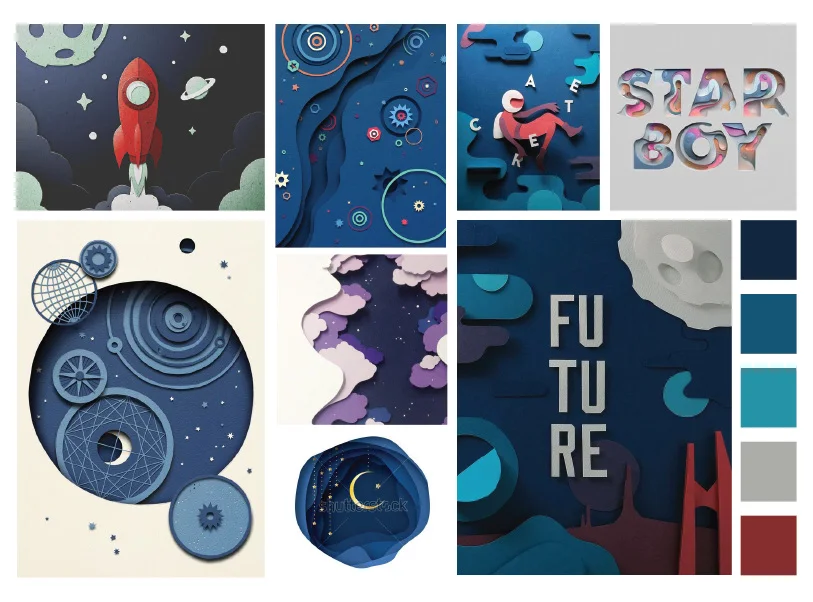Explainer Video
Project 4
Creative Brief
For this project, we - Kara, Megan, Kathy, and Michelle - have decided to pursue a topic in space. Within that domaine we specifically chose to focus on the lifecycle of a star famously known as Betelgeuse. This star is a super red giant star currently that will end up exploding into a supernova creating a light as bright as a full moon in our sky for upwards of 2 weeks. That is just a small example of what can be explained within the video over the progression of the life of Betelgeuse. Before deciding on this idea we toyed around with ideas of how roller coasters work, the connection of sleep and technology, artificial intelligence, and space. We decided to focus on space because it is a topic that fascinates all of us and would be a great opportunity to show off some illustrator skills toying off of previous work done by individual groups members.
Each aspect of this project will play off of each team members strengths. The visuals done in Illustrator will be completed primarily by Megan and Kara. Michelle will primarily focus on the animation of all the videos along with the assistance of Kathy with audio and overall design. In terms of the general aesthetic for the project we want to generally use an abstract feel to the imagery with vectorized images created with a lighter color palette to match the general appearance of a star in different sequences of its life. For the animations, we want to focus on transitions. Especially since our project will need to be approximately four minutes long we want to keep interest peaked throughout the entire video. Furthermore, since there are significant transitions between each of the different life progressions of a star, it would be good to keep that consistency when looking at the overall animation.
Storyboard
Script
Beginning of voice-over:
If you look up at the night sky, you might notice a red speck among the stars. This is Betelgeuse, the second brightest star in the Orion constellation. Even at 640 light years from Earth, Betelgeuse is easily discernible against the backdrop of night sky. But just how did this brilliant red supergiant form, and what is the future of this star?
(Around 3 seconds of pause or something, zoom to nebula)
Birth
The formation of all stars begins with two simple things - hydrogen molecules and dust in the universe. The hydrogen molecules will begin to feel increasing attraction to each other as gravity pulls them together, causing the temperature to rise. The cloud of gas and dust molecules swirl around each other due to gravity and pull in more and more hydrogen in to fuse. The temperature continues to rise. After it reaches 10,000 degrees Kelvin, the hydrogen atoms begin to fuse into helium atoms, and a protostar is formed.
Mid-life
Betelgeuse is a red supergiant star roughly 950 times as large as the sun, making it one of the largest stars known to mankind. It was originally born in the Orion OB1 Association. However, it has since runaway from its birthplace. It’s been moving through the interstellar medium at 30 kilometers per second (18.6 miles per second).
Death
When Betelgeuse stops fusing iron, the last and heaviest element known to be able to fuse in the center of a star, the star will no longer have any outward force against the gravity pulling it in. After Betelgeuse runs out of fuel, the star’s core will begin to collapse and heat up. This will cause the outer layers to expand and cool, and for the star to collapse inwards, bounce off itself, and explode into a supernova.
In doing such, much more massive atoms like gold and silver will be able to eject from this. This could occur as soon as tomorrow, but more than likely, will occur in hundreds of thousands of years.
The supernova is predicted to be as big and as bright as a full moon is on a clear night and visible in broad daylight. This is expected to last approximately two weeks to a month. However, when Betelgeuse blows up, it will bring no harm to life on Earth. Astrophysicists say we would have to be within 50 light-years of a supernova to have any issues, and we are 640 light years away.
Post-death
After Betelgeuse’s supernova, one of two things will happen. The most likely event is that the star compacts into a neutron star. In a neutron star, gravity presses the material into itself so tightly that protons and electrons combine to make neutrons, yielding the name of neutron star. A neutron star is only the size of a city, but a single teaspoon of neutron star material weighs as much as mount Everest. There is also the chance that the star will become a black hole, a very small center in which not even light can escape the object’s insurmountable gravity.
(pause, probably some kind of zoom out as conclusion starts)
This beautiful star is running out of time and fuel, and could technically go supernova as soon as tonight. At around 640 light years away, humans will certainly get a spectacular show. We will, eventually, see what is in store for this red supergiant.







